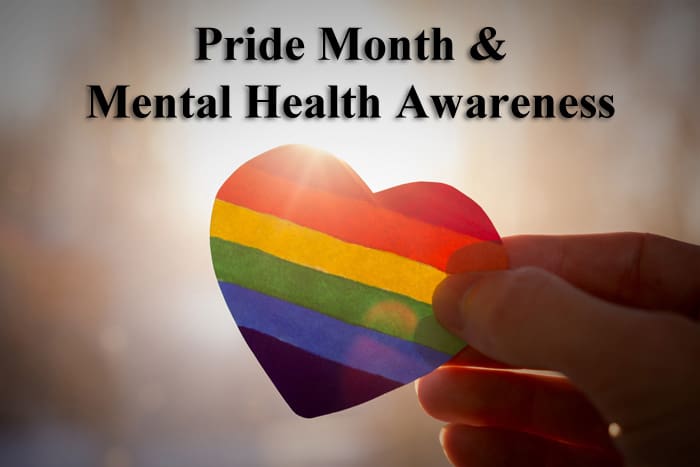
Mental health is just as important as physical health and we know that without good mental health we cannot be entirely healthy. The lesbian, gay, bisexual, transgender, and questioning (LGBTQ+) community faces mental health struggles, just like the rest of the general population, but they may experience more negative mental health outcomes due to prejudices and other biases. Knowing the challenges they may face, as a member of the LGBTQ+ community, can help ensure more positive outcomes with respects to their mental health care.
Mental Health in LGBTQ+ Adults
The LGBTQ+ population are more susceptible to mental health problems than heterosexual people due to a range of factors, including discrimination and inequalities. Mental illness affects all communities, but for LGBTQ+ adults:
- Adults are more than twice as likely to experience a mental health disorder in comparison to individuals that identify as straight (NAMI).
- Approximately 40 percent of adults had a mental illness in the past year, in comparison to the 18 percent of total adults who faced a mental illness in the past year (SAMHSA).
- Individuals are at a higher risk than the general population for suicidal thoughts and suicide attempts.
- Individuals are more likely to abuse substances at an estimated percentage of 20-30% due to factors such as prejudice and discrimination, in comparison to the 9% substance abuse of the general population (NAMI).
Mental Health in LGBTQ+ Youth
The adolescent period is critical for mental health as many disorders often present themselves during this period. LGBTQ+ youth are particularly at risk for mental health disorders because they face many adversities, including bullying, difficulty coming out to friends and family members, hate crimes, lack of support, and fear of stigma and discrimination.
The Trevor Project’s 2020 National Survey on LGBTQ Youth Mental Health provides critical insights around LGBTQ youth mental health disparities, discrimination, housing instability, barriers to affirming health care, subjection to conversion therapy, and suicide. Representing the experiences of over 40,000 LGBTQ youth ages 13-24 across the United States, it is the largest survey of LGBTQ youth mental health ever conducted.
According to the survey:
- 55% of LGBTQ youth reported symptoms of major depressive disorder in the past two weeks, including more than 2 in 3 transgender and nonbinary youth.
- 86% of LGBTQ youth said that recent politics have negatively impacted their well-being.
- Nearly 15% of LGBTQ respondents attempted suicide in the past twelve months, including more than 1 in 5 transgender and nonbinary youth.
- 48% of LGBTQ youth reported engaging in self-harm in the past twelve months, including over 60% of transgender and nonbinary youth.
Suicide Risk for LGBTQ+ People
Actual suicide rates among LGBTQ people are not known because sexual orientation and gender identity are not reported in death records.1 What we do know about suicidality among LGBTQ people is through surveys in which people self-report suicide attempts and ideation. According to a number of regional and national studies, LGBTQ adults and youth face an extraordinarily elevated risk of suicidal thoughts and behavior. LGBQ adults have a two-fold excess risk of suicide attempts compared to other adults. Among transgender adults, the lifetime prevalence of suicide attempts is 40%.
Suicide is sill a public health crisis and continues to disproportionately impact LGBTQ youth. Suicide risk in LGBTQ people is thought to be highest during the teen years and early 20s.
- Suicide is the 2nd leading cause of death among all young people ages 10 to 24.
- 40% of LGBTQ respondents of the survey seriously considered attempting suicide in the past twelve months, with more than half of transgender and nonbinary youth having seriously considered suicide.
- 48% of LGBTQ youth reported engaging in self-harm in the past twelve months, including over 60% of transgender and nonbinary youth.
- Nearly 15% of LGBTQ respondents attempted suicide in the past twelve months, including more than 1 in 5 transgender and nonbinary youth.
- More than half of transgender and nonbinary youth have seriously considered suicide.
 An often overlooked population when discussing suicide are older LGBTQ adults (65 years and over).2 Older adults in the general population account for close to 17% of fatal suicides even though they currently make up about 15% of the total U.S. population, according to the CDC. Again, the percentage of completed suicides in LGBTQ people is unknown; however, older LGBTQ adults have endured a long life of stigmatization, and some studies have found higher rates among LGB older adults compared to their straight peers.
An often overlooked population when discussing suicide are older LGBTQ adults (65 years and over).2 Older adults in the general population account for close to 17% of fatal suicides even though they currently make up about 15% of the total U.S. population, according to the CDC. Again, the percentage of completed suicides in LGBTQ people is unknown; however, older LGBTQ adults have endured a long life of stigmatization, and some studies have found higher rates among LGB older adults compared to their straight peers.
Family support plays a particularly important role in affecting the likelihood of suicide. Someone who faced rejection after coming out to their families were more than 8 times more likely to have attempted suicide than someone who was accepted by their family after revealing their sexual orientation. With this high risk associated with both the LGBTQ+ adults and youth, reaching out for help and treatment is vitally important.
Mental Health Care
Though more therapists and psychiatrists today have positive attitudes toward the LGBTQ+ community, people still face unequal care due to a lack of training and/or understanding. Health care providers still do not always have up-to-date knowledge of the unique needs of the LGBTQ community or training on LGBTQ+ mental health issues. Providers who lack knowledge and experience working with members of the LGBTQ+ community may focus more on a person’s sexual orientation and/or gender identity than a person’s mental health condition.
Building resilience in LGBTQ+ people can set them on a path to better mental health and life adjustment. Factors that strongly protect LGBTQ people, especially youth, against spiraling into depression and suicidal behavior include:
- Acceptance by family of origin (e.g., parents, siblings, grandparents, children)
- Having a supportive social network made up of LGBTQ friends, allies, and family of choice (close relationships with people who are not biologically related but who act as a family)
- Access to and use of LGBTQ inclusive medical and mental health.
Choosing a Mental Health Provider: There is HOPE
Providers need to do a better job to support the LGBTQ+ adult and youth community. We at BryLin Hospital do not have all the answers, but we do have a very diverse, compassionate, and professional staff who can meet the behavioral health needs of people from all walks of life. Over the years, we’ve implemented several training’s which are used to educate our providers and our care-givers. The training is focused on allowing for open, non-judgmental communication while providing a safe environment for learning.
We have a team of compassionate professionals that understand the connection between your sexual orientation and your mental health. If you identify as LGBTQ+ and would like to talk with someone about your mental health, please call BryLin at (716) 886-8200 to speak with a mental health professional. Let our experience be your guide to mental wellness. With HELP, There’s HOPE
References:
1. Haas AP, Eliason M, Mays VM, et al. Suicide and suicide risk in lesbian, gay, bisexual, and transgender populations: review and recommendations. Journal of Homosexuality. 2010;58(1):10-51.
2. Centers for Disease Prevention and Control. Fatal Injury Reports, 1999-2016. Available at https://www.cdc.gov/injury/wisqars/fatal.html. Accessed April 30, 2018.


Comments are closed